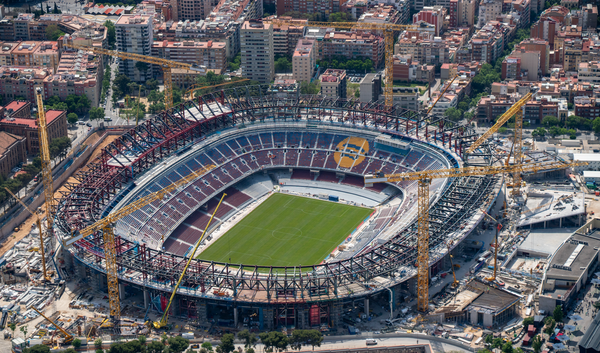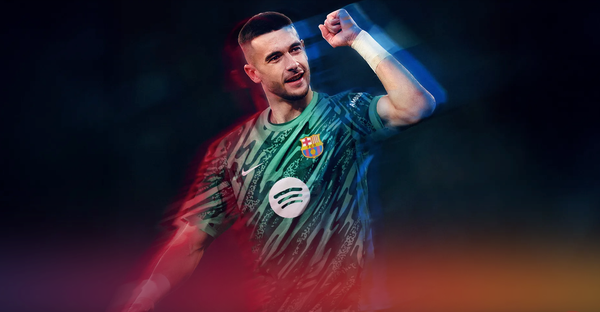Manipulation, isolation and dynamic superiority: Inside Xavi's brilliant mind
Xavi has a brilliant football mind. Can he temper that with man management and match experience to evolve into an elite coach?
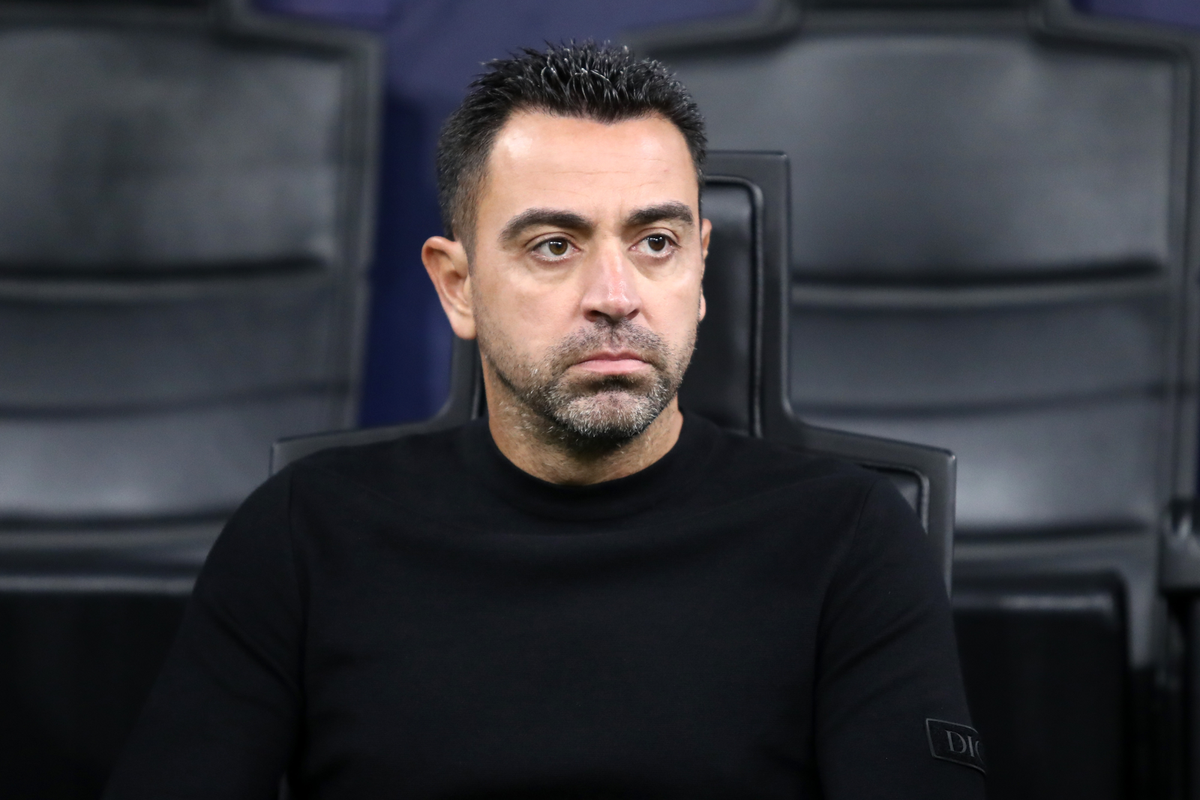
It’s been over a year since Barcelona appointed Xavi Hernández as their new coach. But the honeymoon phase proved to last shorter than most had imagined and soon, the Catalans - and their fanbase - found themselves wanting more. Yearning for it, even.
Yet, Xavi’s Barcelona project is as tough as they come. Navigating through a financial crisis, a team ridden with unfitting profiles and a massive fall from grace would be a task too daunting for most, let alone a largely inexperienced coach. Perhaps inexperience is the wrong word, though. Xavi has very little experience as the man on the sidelines but perhaps crucially, a lifetime of it playing at the very peak of the mountain.
And that experience is the foundation on which Barcelona need to build their future. Xavi sees football in ways most can only dream of. In that manner, he could be compared to the world’s best.
Translating that onto the pitch, however, is what he’s yet to fully master. But despite the inevitable ups and downs, we are seeing glimpses of what could be; snippets of brilliance that instil hope.
Here are some of them.
What makes a good coach?
At Barcelona, and indeed at most top-tier clubs across the globe, results take precedence over anything else. A good coach is a coach that wins. However you turn this, however you try and go around it, football comes down to winning and winning only. Barcelona, of course, claim to be different; here you not only have to win but have to win playing a certain style. You have to win AND dominate the opponent.
This inevitably makes success that much more difficult to reach but the rewards for doing so are also bigger. That’s why successful Barcelona coaches are immortal in the football sense; they go straight into the football pantheon. And the same is true for their players. But at Barcelona, there is also little middle ground. You either win and claim glory or you don’t. It’s as simple as that.
For a coach like Xavi, this is true baptism by fire; immortality and the abyss looming at either end. They serve as the carrot at the end of the stick and the black hole burning at his heels. It’s an unenviable position to be in. But then again, nothing worth anything in life is free or easy to attain, for that matter. What makes this particular job in question so difficult, however, is its project-like nature.
Barcelona are a work in progress in every sense of the word: they’re green, newly assembled, and fresh out of the workshop. So one may argue the maturity of Barcelona’s players is something to consider here too. Indeed, a squad with such a young spine is exciting but not without its drawbacks. Players like Pedri or Gavi, as brilliant as they may be, lack certain mechanisms you only unlock as you gain more experience. In fact, that may be the reason why Xavi is so reluctant to part ways with veterans such as Sergio Busquets or Jordi Alba, as unimaginable as it may seem to the outside world.
Then there’s the sheer quality and quality in depth. Barcelona may have had an unreal summer with high-profile players like Robert Lewandowski and Jules Koundé joining but the fact remains: they are still thin in certain key areas of the squad. Xavi’s capacity to coach that team, with all of their virtues and flaws, however, is what will make or break his Barcelona career
Good players cannot make the system, they can only elevate it. In that sense, Xavi cannot hide behind the lack of quality forever. The good news is, he doesn’t intend to. We’ve heard him call the squad ‘perfect’ and ‘complete’ on multiple occasions and while that may be objectively far from the truth, it’s also a key takeaway: A good coach needs to be able to build a good team - a team with solid principles, clear mechanisms and cohesion - regardless of the innate quality of his players. Xavi seems to believe he has everything he needs to make that happen at the Camp Nou. This is important.
“I don't want anyone to leave. I'm delighted with the squad. It seems there won't be a market for us [in January] as I'm happy with what I have,” he said in the build-up to the clash against Atlético Madrid.
But strong belief alone is not enough. Luckily, Xavi’s understanding of football is what separates him from the rest. And that is something palpable, something real and something that can be analysed too.
So let’s do it.
Xavi’s bane & the theory behind deep-block unlocking
In the early stages of Xavi’s Barcelona journey, the young coach struggled to unlock deep defensive blocks, especially ones with 5-at-the-back structures. This in itself isn’t a big surprise. A good defensive block is always a headache to unlock and it often falls to the coach’s ingenuity and the quality of his players to beat it.
Many will recall Barcelona’s ultimately unsuccessful two-game bout against Inter Milan in the Champions League. The Catalans’ dreams were shattered as they failed to win either of the two legs against their Italian counterparts. But despite a heavy setback, we did get a glimpse into Xavi’s mind.
The first leg was horrible: Barcelona were slow, idealess and beaten across the park. Interestingly, it was the 5-at-the-back structure, Xavi’s bane, that got the better of them that night. So Inter’s decision to replicate the system in the return leg came as no surprise. What was surprising, however, was Xavi’s response. He chose to face his demons head-on.
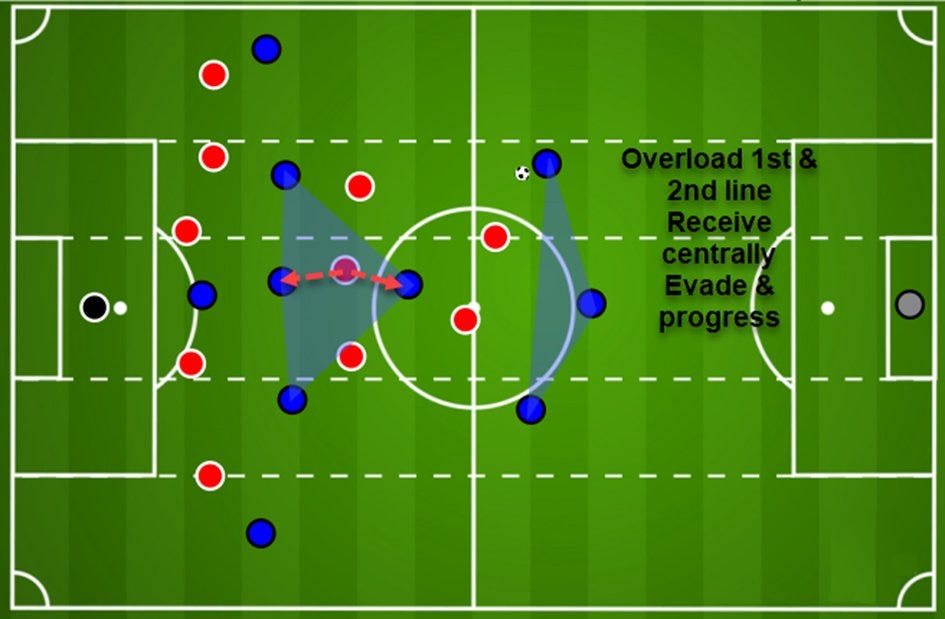
In preparation for Xavi’s clash against Diego Simeone, I made a huge thread previewing the game. This ~50-tweet juggernaut included two of my personal takes on dismantling the 5-at-the-back system, the first of which you can see above. The whole premise behind it is to overload the central areas and use Barcelona’s exceptional quality between the lines to receive under pressure, evade and then progress & eject.
It’s a very difficult sequence to execute as it requires great receivers and progressors in tight spaces. Luckily, however, in Pedri, Gavi and Frenkie de Jong, Barcelona have exactly that. It doesn’t surprise then that Xavi utilised this both against Inter in the 3:3 return leg and the clash against Atlético Madrid. Granted, the Inter setup looked more akin to my idea with the diamond in midfield while the structure against the Rojiblancos was a 3-2-5 I recommended in my second, more complex solution you can see below.
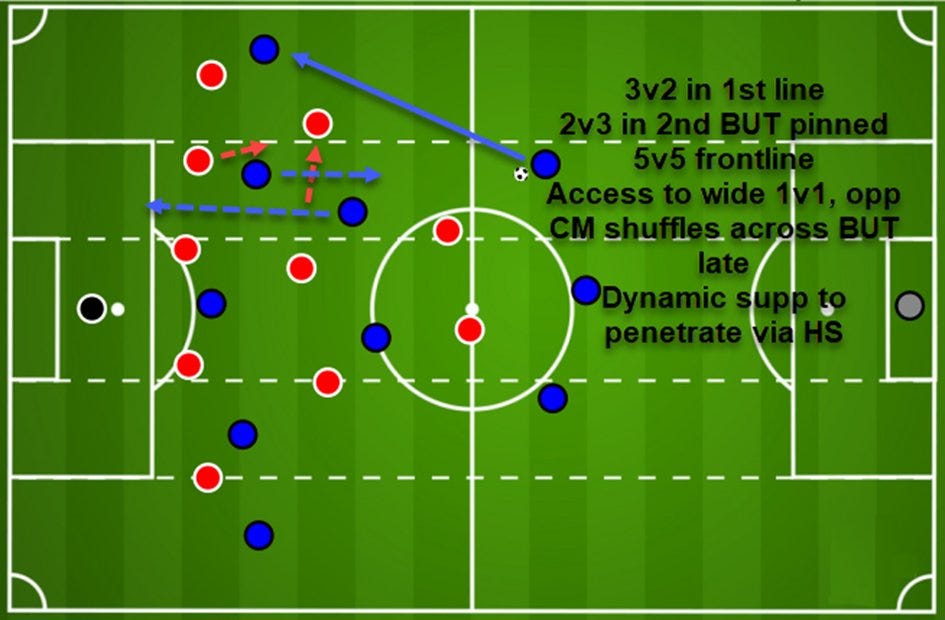
This setup combats the 5-3-2 with its mirror of 3-2-5. The idea is to use dynamic superiority and half-space penetrators to dismantle the block. Essentially, it makes use of Atlético Madrid’s heavy man-marking orientation to manipulate movement and exploit gaps once they appear. And that’s exactly what happened in the game.
The 3v2 in the first line guarantees progression and the second-line pinning ensures access to your wide receivers. How? The two midfielders may be outnumbered centrally (2v3) but they’re pinning the opposition midfield who have to screen against the free wide centre-backs’ potential inside passes. That means they have to stay narrow as long as possible to avoid vertical progression down that channel and in turn, they will be late to cover out wide if they even commit to shuffle across. As a result, Barcelona’s wide receivers are far more easily isolated with their markers.
Once that happens, through rotation and dynamic superiority in their favour, it becomes easier to eject runners through the half-space. It’s possible for the winger to eject the interior/striker or the interior to eject the winger - whichever comes first or is easier at any given time. But that was all just a theory I had before the game. Interestingly, however, Xavi had similar ideas too.
Against Inter, he went with the diamond midfield which made it extremely difficult for the opposition to man-mark properly. Overloading the middle to progress is something Barcelona are quite good at because of their overwhelming technical quality. So approach number 1 is what we’ve seen then and approach number 2 is what Xavi would utilise against Simeone. However, somewhere in-between those two games, Barcelona also faced Intercity in the Copa del Rey.
In that clash, Xavi came face to face with the 5-at-the-back block once more and despite a serious struggle, he prevailed again. Of course, the quality of the opposition is critical here too but it’s the principles we have to look at.
A lot has already been said about both the game against Atlético and the one against Intercity but I’ll use those two to show three main aspects Xavi had adapted to breach the 5-at-the-back deep blocks: manipulation, isolation and dynamic superiority.
Xavi’s adaptation
Ever since Xavi’s arrival, Barcelona’s greatest threat has been in the wide areas. Given the players they have in those positions, this doesn’t come as a big surprise. In fact, it’s been tough not to somewhat rely on the (frustrating) brilliance of Ousmane Dembélé or his counterpart Raphinha. But somewhere along the way, this system became predictable.
So much so that teams began to structure specifically for it, doubling down on the flanks to prevent isolations. The 5-at-the-back system was especially effective at this.
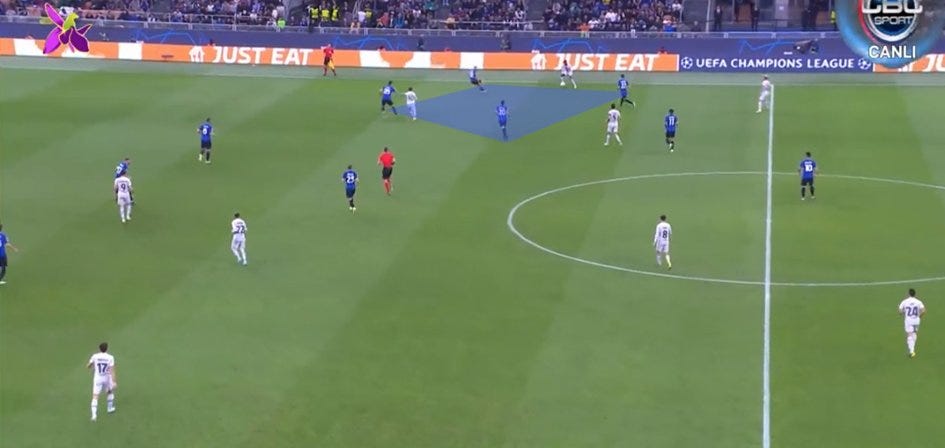
Inter suddenly became the blueprint to follow: ensure Dembélé receives the ball deep and wide and if he somehow makes it into the final third, there would be no fewer than two (sometimes even more) markers right on top of him. This approach seems simple enough but it requires compactness to prevent quick switches and cohesion to maintain it.
But Xavi has learned a lot since the Inter clash and most importantly, he’s been evolving and adapting consistently. Stubbornnessly forcing the same system against this structure was not an option. That’s how the latest iterations of Barça’s approaches were born. Let’s take a look at a couple of examples from the two freshest games: Intercity and Atlético Madrid.
Speaking of the former game, it was tough to find silver linings considering the level of the opposition. However, neglecting them would’ve also been unfair. Even though this was more of a natural 4-3-3, Xavi found ways to overload to isolate properly. This remains Barcelona’s biggest weapon in attack.
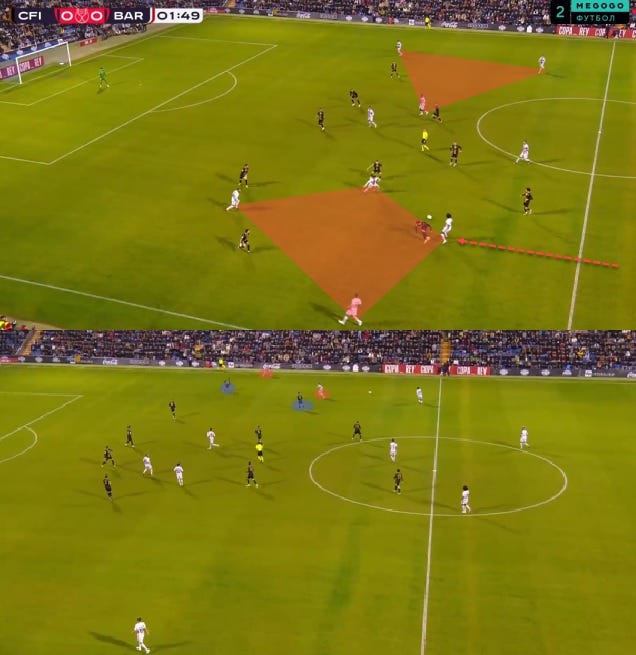
The sequence above is a great example. When breaching compact blocks, ball-carriers and dribbles are especially important as they force opposition movement. Xavi uses the back three formation to achieve numerical superiority in the first line, which then allows his wide defenders to progress either via passing or carrying. In this example, Kounde carries the ball forward which immediately catches the attention of multiple Intercity players.
Barcelona then quickly recycle the ball and switch sides. Again, the wide defender plays a key role in orchestrating the attack: the numerical superiority allows him to carry the ball once more, only this time, since the ball had been shifted quickly enough, the opposition’s block cannot recover in time and Barcelona achieve either an isolation of their winger or a full overload, like below.
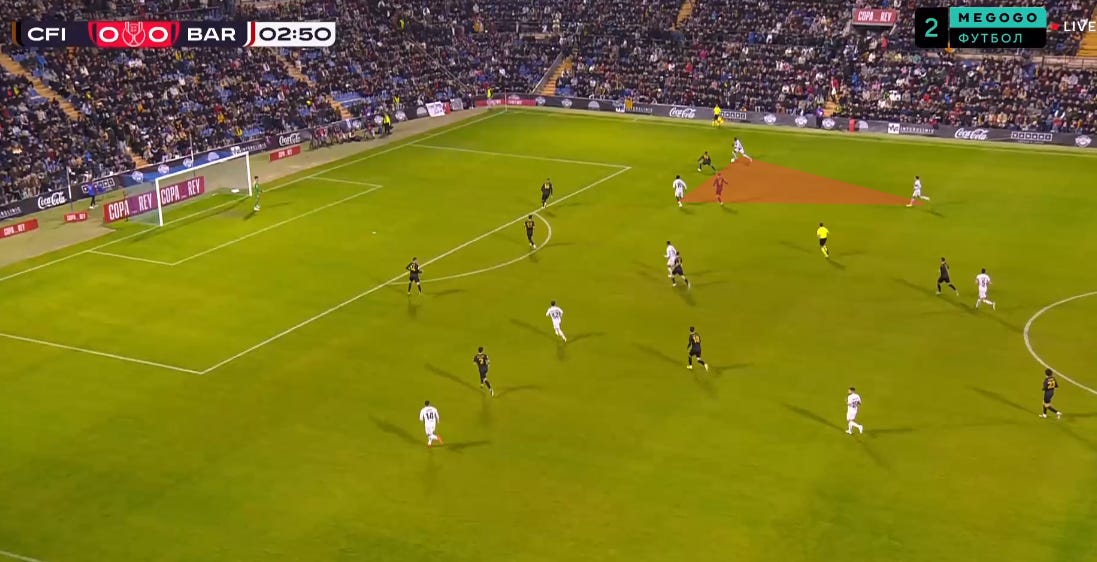
Obviously, due to the difference in quality, Barcelona had an easier time imposing themselves against Intercity. Against Atlético Madrid, however, Xavi had to properly outsmart Simeone to achieve a similar result. This is also where profiles come into play. We’ve discussed receivers and carriers in the previous section but those same aspects come into play here as well.
Barcelona are a team with an abundance of technical quality in the central areas and that’s naturally where their progression tendencies often lie. So having Pedri and Gavi occupy the interior roles, De Jong being in the deep left half-space and Kounde in the right one was crucial. Pedri and Gavi are excellent in tight spaces and under pressure while De Jong and Kounde offer clean progression via carrying and passing respectively.
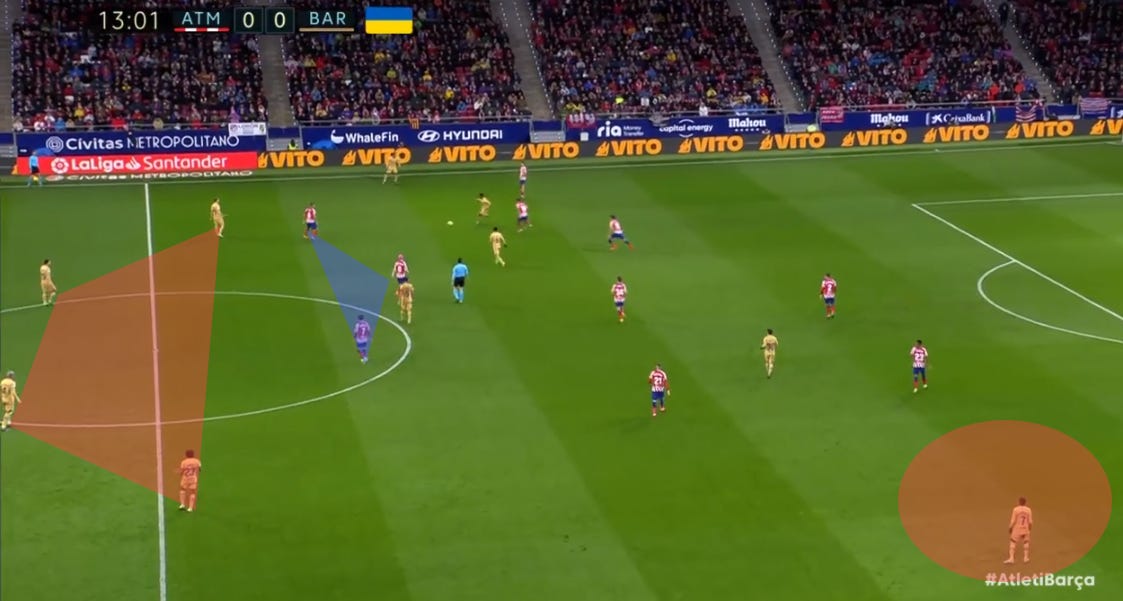
The setup above can tell us more: numerical superiority in the first line, technical players between the lines, progressors on both sides of the backline and a wide isolation. This is the gist of Xavi’s deep block dismantling tactics. But we also have to discuss manipulation and dynamic superiority, both of which are key aspects of this setup.
Atlético Madrid are exceptionally well organised but also practice a heavy man-marking approach. This played right into Xavi’s hands. Manipulation and dynamic superiority are two interconnected terms; one enables the other. Dynamic superiority is all about timing and movement. If the attacker from the deep is already in motion while the defender is stationary, the former player has a dynamic advantage.
Take this example from below.
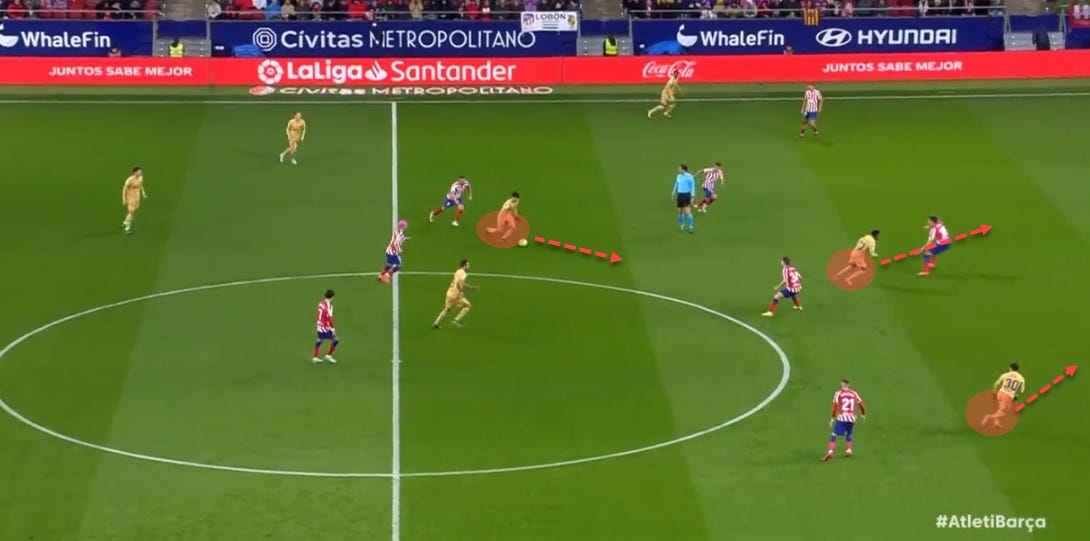
Pedri is carrying the ball upfield and Fati and Gavi have a dynamic advantage over their markers. Notice how they’re both already in motion while the defenders have to first turn and then start their runs. Generally, this is done by quickly changing directions, as is often the case with strikers who drop deep.
Ansu Fati, for example, is a good profile for such a task. While he may not be as explosive as he used to be, he’s still agile enough to switch directions and unbalance his markers, like in the image above. But Barcelona used their profiles exceptionally well against Atlético. Seeing how Pedri is comfortable dropping deep and orchestrating while De Jong thrives when starting deep and finishing high, reversing their role came naturally to them.
When you add the man-marking tendencies of the Rojiblancos, this was a recipe for success.
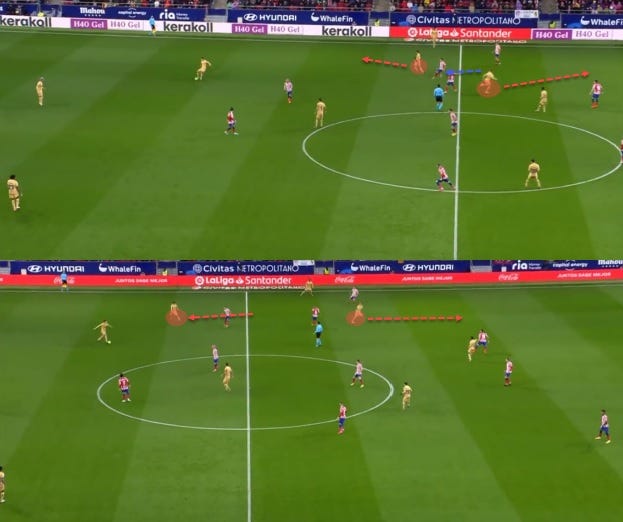
Pedri would regularly drop deep, dragging his marker across and De Jong would then promptly exploit that space, exploding from the deep to penetrate the half-space with his motion. Manipulation + dynamic superiority. For the first 20 minutes, it was generally easy for Barcelona to move Atlético Madrid’s block around, manipulating them as they pleased.
Here’s one of the sequences I loved best that doesn’t end up in a goal. Of course, the solitary strike from Dembélé also came as a result of a great action but this one had all the elements we discussed so far: manipulation, isolation and dynamic superiority.
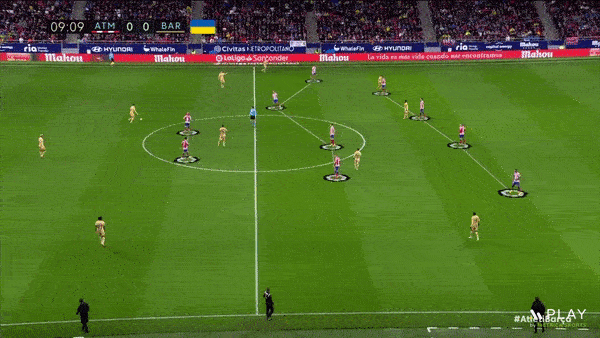
Intriguingly, this wasn’t the only sequence worth dissecting. Barcelona used these mechanics and their profiles well, maximising their efficiency and exploiting the opposition. Notice how here, Barcelona opted to progress through the middle but there was also an option to recycle the ball quickly from left to right, going horizontally instead of vertically.
Both approaches require exceptional technical quality and passing speed. Going through the middle, however, would be deemed riskier and more difficult to execute. But due to Barcelona’s individual quality and Xavi’s setup which countered Simeone’s, it was a viable strategy.
The Catalans used both of those aspects to their advantage, though. Notice in the following sequence how a 4v4 scenario out wide still results in an advantage for the Blaugrana.
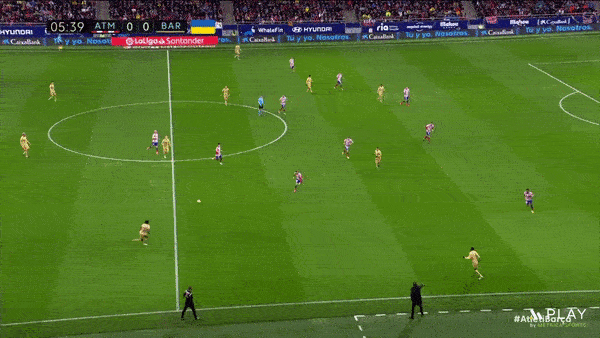
Again, all three aspects of our analysis are present: isolation - Barcelona achieve a 4v4 on one side and 2v2 on the other. Manipulation - dragging the opposition players to create a passing lane. Dynamic superiority - Fati attacks space, exploding from a standstill to take the defenders off guard. Sadly, the line-breaking pass is intercepted and the attack breaks down.
But at this point, that’s not as important. What is important are the principles and mechanisms that got Barcelona into that situation in the first place.
Final remarks
A 4:3 victory over a third-division side and a slim 1:0 triumph where you barely survived don’t seem like much. However, it’s the underlying principles and mechanisms that matter. They are the foundations for future success; a potential indicator of greatness.
Xavi has been a very perplexing coach so far and there’s no escaping the fact Barcelona have been shaky because of it. However, improvement can already be seen, albeit inconsistently. If you look hard enough, there is a genuine reason to be optimistic.
The new system we’ve seen since the break isn’t all that new at all. We’ve seen its iterations during Xavi’s tenure before. But the profiles are optimised, the plan clearer and the team is more prepared to tackle specific issues posed by specific opponents.
All of that is on Xavi. And all of that is a sign of a good coach. One that will soon hopefully become a great one.


